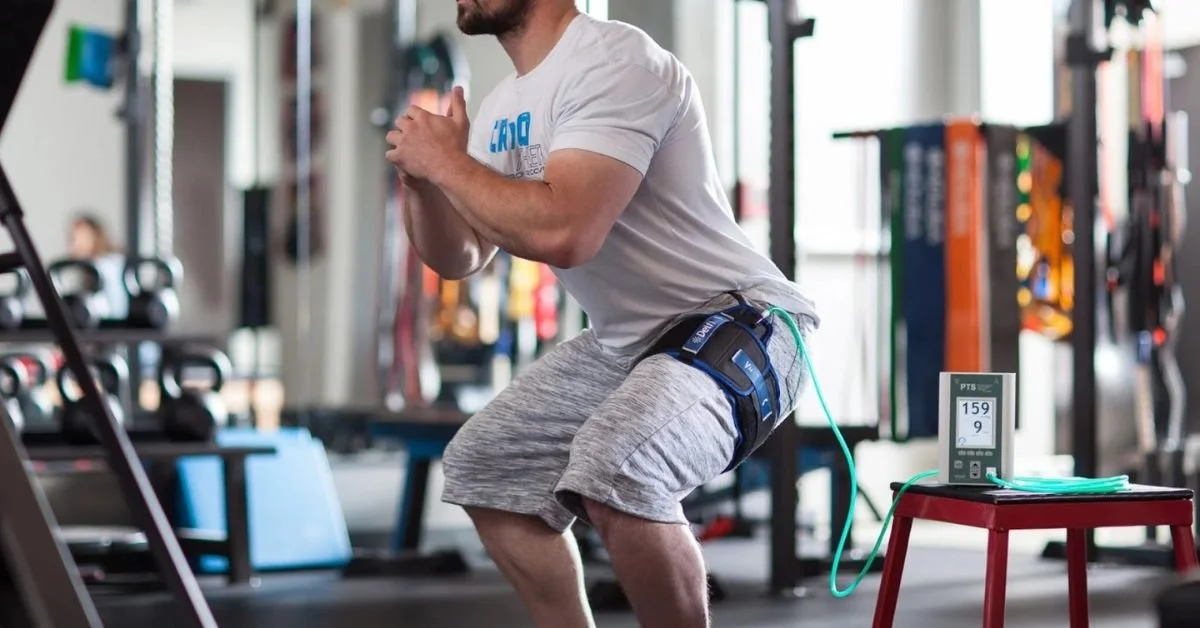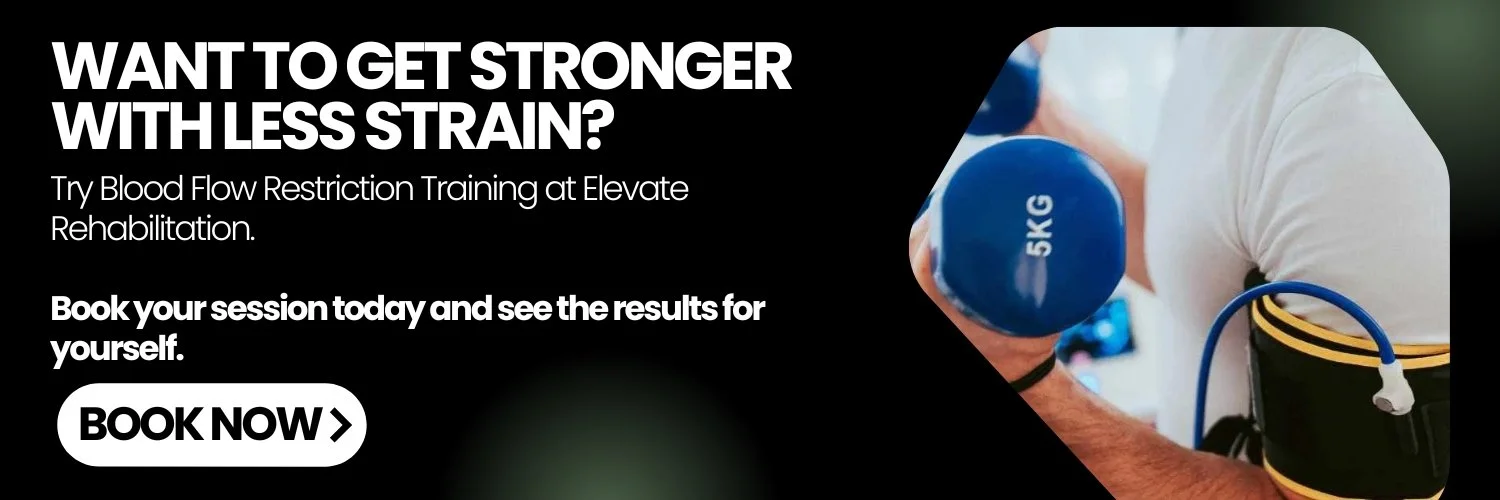What Is BFRT? Blood Flow Restriction Training Explained
Have you ever wondered how you could build strength without lifting heavy weights—especially after an injury or surgery? That’s where blood flow restriction training (BFRT) comes in. In this article, we’ll cover what BFRT is, how it works, and why physiotherapists in Oakville are using it to help patients rebuild strength safely and efficiently.
At Elevate Physiotherapy in Ontario, our clinicians use BFRT as part of advanced rehab programs to help patients recover faster while protecting healing tissues.
What Is BFRT and How Does It Work?
Blood flow restriction training explained simply: BFRT uses specialized cuffs placed around your arms or legs to partially reduce blood flow while you exercise with light weights. Even though you’re lifting only 20–30% of your maximum strength, your body responds as if you’re lifting heavy.
This method is supported by decades of research and is widely used in physiotherapy, rehabilitation, and sports performance.
Key Benefits of BFRT
Build muscle with lighter weights
Protect joints and healing tissues
Maintain strength during recovery
Support faster rehabilitation after injury or surgery
How BFRT Works: The Science Explained
Understanding the mechanisms of BFRT helps explain why this approach is so powerful.
1. Occlusion
The cuff partially restricts blood flow, forcing your muscles to work harder even with lighter weights.
2. Hypoxia
Your muscles experience a low-oxygen environment. This activates fast-twitch muscle fibers that are normally only recruited during heavy lifting.
3. Metabolic Stress
Lactic acid and other byproducts build up in the muscles, creating the “burn” that signals your body to grow stronger.
Together, these effects trigger muscle protein synthesis and hormonal responses—the same biological pathways activated by heavy resistance training.
Equipment Used in BFRT: Pressure Cuffs and Bands
Professional BFRT uses pneumatic pressure cuffs connected to a control unit. These devices let you set exact pressure levels for safe training.
The cuffs are wider than regular blood pressure cuffs. They're usually 3-5 inches wide for arms and 4-6 inches wide for legs. Width matters because it affects how much pressure reaches your blood vessels.
Professional equipment features:
Digital pressure gauges
Automatic pressure maintenance
Safety release valves
Different cuff sizes
Some people use elastic bands or knee wraps instead of pneumatic cuffs. However, these don't provide consistent pressure. The pressure can change as you move or as the band stretches.
Proper pressure is crucial for safety and results. Too little pressure won't create the desired effect. Too much pressure can completely stop blood flow, which is dangerous.
Safety tip: BFRT should only be done under professional supervision. Incorrect cuff use can be unsafe.
How BFRT Stimulates Muscle Growth
During BFRT sessions:
Low oxygen forces the body to recruit more muscle fibers
Cellular swelling signals the body to grow muscle tissue
Hormonal responses (like increased growth hormone) accelerate recovery
Research shows BFRT can increase muscle size by 6–12% within 6–8 weeks, even with light resistance.
Comparing BFRT to Traditional Strength Training
Traditional Training
Blood Flow Restriction Training
Heavy loads (65–85% 1RM)
Light loads (20–30% 1RM)
High joint/tissue stress
Lower joint/tissue stress
Longer recovery times
Faster recovery between sessions
Not always safe post-injury
Safe option for rehab patients
Health Benefits, Rehabilitation, and Safety Considerations
Blood flow restriction training offers significant advantages for injury recovery and cardiovascular fitness when applied correctly. However, proper supervision and understanding of contraindications are essential for safe implementation.
BFRT in Sports Injury and Surgical Rehabilitation
Why BFRT Helps in Rehab
BFRT is ideal for people who can’t yet tolerate heavy loads due to:
ACL or knee surgery
Rotator cuff or shoulder injuries
Chronic joint pain or arthritis
By allowing strength gains with lighter loads, BFRT:
Prevents muscle loss during recovery
Reduces re-injury risk
Supports a faster return to activity
BFRT and Cardiovascular Health
When paired with light aerobic activity (walking or cycling), BFRT also:
Improves vascular function
Boosts endurance with lower intensity
Enhances circulation and capillary density
Is BFRT Safe?
Yes—when supervised by a trained physiotherapist. At Elevate Physiotherapy, we assess your health history, check for contraindications, and monitor you throughout your sessions.
Not suitable for patients with:
Uncontrolled high blood pressure
History of blood clots
Severe cardiovascular conditions
Pregnancy
If BFRT isn’t appropriate, our physiotherapists at Elevate Rehabilitation will recommend alternative treatments to support your recovery.
BFRT in Practice: Guidelines, Best Use Cases, and BFRT Oakville
Proper BFRT implementation requires specific pressure settings, appropriate exercise selection, and trained supervision to maximize safety and results. Athletes recovering from injury, older adults, and those seeking muscle gains with lighter loads can all benefit from this approach.
Recommended Protocols and Programming
Your BFRT sessions should use 20-30% of your one-rep max for resistance exercises. This light load feels easy at first, but the restricted blood flow changes everything!
Pressure Guidelines:
Arms: 50-80% of limb occlusion pressure
Legs: 40-80% of limb occlusion pressure
Duration: 15-20 minutes maximum per session
The classic rep scheme follows a 30-15-15-15 pattern with 30-second rest periods between sets. Your first set targets 30 reps, followed by three sets of 15 reps each.
You can train with BFRT 2-3 times per week. Allow at least 48 hours between sessions targeting the same muscle groups.
Exercise Selection:
Walking or cycling for cardio
Squats, lunges, or leg extensions for legs
Bicep curls, tricep extensions for arms
Resistance band exercises work well, too
Who Can Benefit from BFRT
Athletes recovering from injury find BFRT particularly valuable. You can maintain muscle mass and strength even when heavy lifting isn't possible.
Older adults experience significant muscle-building benefits. The lighter loads reduce joint stress while still triggering muscle growth pathways.
Physical therapists often recommend BFR training for patients with:
Post-surgical limitations
Chronic joint pain
Muscle weakness conditions
Bone density concerns
You're also a good candidate if you travel frequently. BFRT requires minimal equipment compared to traditional strength training.
People with time constraints benefit too. Sessions last just 15-20 minutes but deliver muscle gains similar to longer, heavier workouts.
BFRT Oakville: What to Expect at Elevate Physiotherapy
When you come to Elevate Physiotherapy in Ontario, your BFRT program includes:
Comprehensive assessment (medical history, limb measurements, baseline strength)
Personalized cuff calibration for safe occlusion levels
Supervised exercise sessions (typically 15–20 minutes)Progress tracking to measure strength improvements
BFRT sessions are often combined with manual therapy, mobility work, and traditional physiotherapy exercises for a well-rounded recovery.
FAQs About BFRT
1. What is BFRT and how does it work?
BFRT uses specialized cuffs to reduce blood flow while you perform low-load exercises. This tricks the body into thinking it’s working harder, stimulating muscle growth.
2. How soon after surgery can I start BFRT?
Many patients start within weeks of surgery (with surgeon approval and therapist supervision).
3. Does BFRT hurt?
You’ll feel pressure and muscle fatigue, but not sharp pain. The loads are light, which makes it joint-friendly.
4. Is BFRT safe for older adults?
Yes. BFRT is especially beneficial for older patients who can’t safely lift heavy weights.
Take the Next Step with BFRT in Oakville
If you’ve been told to “take it slow” after surgery—or if heavy lifting feels impossible—blood flow restriction training could help you recover strength faster and safer.
👉 Book your BFRT consultation today with Elevate Physiotherapy in Ontario. Our certified clinicians are here to explain how BFRT fits into your recovery journey.
Book an Appointment


